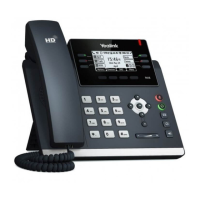










Do you have a question about the Yealink SIP-T41S and is the answer not in the manual?
| Mounting | Desk/Wall |
|---|---|
| Handset type | Wired handset |
| Product type | IP Phone |
| Product color | Black |
| Keypad illumination | Yes |
| Wi-Fi | No |
| Networking standards | IEEE 802.3af |
| Ethernet LAN data rates | 10, 100 Mbit/s |
| Ethernet LAN interface type | Fast Ethernet |
| Supported network protocols | SIP v1, SIP v2, LLDP/CDP/DHCP, OpenVPN, IEEE802.1X, IPv6, FTP/TFTP/HTTP/HTTPS |
| Volume control | Digital |
| Number of programmable keys | 6 |
| Lines quantity | 6 lines |
| Phonebook capacity | 1000 entries |
| Dual-Tone Multi-Frequency (DTMF) modes | In-band, Out-of band, SIP info |
| Input frequency | 50/60 Hz |
| AC adapter input voltage | 100 - 240 V |
| AC adapter output current | 1.2 A |
| AC adapter output voltage | 5 V |
| Display diagonal | 2.7 \ |
| Display resolution | 192 x 64 pixels |
| Operating temperature (T-T) | -10 - 50 °C |
| Operating relative humidity (H-H) | 10 - 95 % |
| Voice codecs | CNG, G.711Mu, G.711a, G.723.1, G.726, G.729ab, VAD, iLBC |
| Certification | CE |
| Cables included | LAN (RJ-45) |
| Number of handles included | 1 pc(s) |
| Harmonized System (HS) code | 85171800 |
| Depth | 189 mm |
|---|---|
| Width | 212 mm |
| Height | 175 mm |
| Package depth | 223 mm |
| Package width | 246 mm |
| Package height | 120 mm |
Outlines necessary network setup using DHCP or static IP addresses.
Guides on configuring DHCP for IPv4 or IPv6 network settings.
Provides steps to configure a static IPv4 address for network connection.
Details the procedure for configuring a static IPv6 address for the IP phone.
Covers managing contacts, including local directory, blacklist, and remote phone book.
Explains storing and managing contacts and groups in the local directory.
Explains the blacklist feature to automatically reject incoming calls from specific numbers.
Covers managing call history lists: missed, placed, received, and forwarded calls.
Introduces DSS keys: Line Keys, Programmable Keys, and Ext Keys.
Guides on entering the line key settings screen via phone or Idle screen.
Covers customizing soft keys, navigation keys, and function keys.
Explains the dial plan for processing dialpad inputs and basic expression syntax.
Guides on configuring replace rules to speed up dialing by replacing patterns with wildcards.
Explains configuring dial now rules for automatic dialing when dialed numbers match specific strings.
Guides on configuring area codes to add prefixes when dialing numbers outside the local plan area.
Explains configuring numbers to be blocked from dialing out, displaying 'Forbidden Number'.
Explains various methods for placing calls, including multiple calls and speed dial.
Provides basic steps for placing a call using handset, speakerphone, or headset.
Explains placing calls using recent call records or search source lists.
Covers various methods for answering incoming calls, including single or multiple calls.
Guides on enabling auto-answer using the speakerphone for incoming calls.
Details enabling/disabling call waiting for multiple calls and managing warning tones.
Covers enabling auto redial for busy numbers and configuring redial attempts/intervals.
Explains notifying the caller when a party becomes available after a failed call attempt.
Explains muting the microphone during calls or while dialing.
Covers placing active calls on hold and resuming them.
Explains activating DND to automatically reject incoming calls and log them as missed.
Details DND modes: Phone (system-wide) and Custom (per account).
Covers forwarding incoming calls to another party or while the phone is ringing.
Explains Always, Busy, and No Answer forwarding types.
Details Phone (system-wide) and Custom (per account) modes for call forwarding.
Explains manually forwarding an incoming call while the phone is ringing.
Covers transferring calls via Blind, Semi-Attended, or Attended methods.
Explains the procedure for performing a blind transfer of a call to another party.
Guides on performing semi-attended and attended call transfers.
Covers setting up 3-way local and multi-way network conferences.
Explains the default three-way conference call setup between active and held calls.
Guides on configuring network conference settings, including conference URI.
Covers parking calls to hold them and retrieving them from other phones.
Explains FAC mode for call parking: local or desired extension parking.
Explains call parking using transfer mode to a shared parking lot.
Covers answering incoming calls to other phones using directed or group call pickup.
Explains directed call pickup to answer calls for another specific phone.
Explains group call pickup to answer calls within a predefined group.
Explains placing calls without revealing caller ID and configuring on/off codes.
Covers automatic rejection of calls from blocked caller IDs and configuring rejection codes.
Explains local and server call recording via USB flash drive and record key.
Covers broadcasting audio announcements to multicast groups over specific channels.
Covers the ACD system for handling large volumes of incoming calls, distributing them to agents.
Guides on configuring a DSS key for the ACD feature.
Explains how to log into the ACD system using the ACD key.
Explains sharing an extension across multiple IP phones with different line icons indicating status.
Guides on configuring SCA feature, assigning DSS keys for shared lines.
Provides info on using IP phone in SCA Hybrid Key System, including line key status changes.
Allows sharing a SIP line across phones, monitoring extension status, depends on SIP server.
Guides on configuring BLA feature, sharing lines, and assigning DSS keys.
Explains resetting the phone to factory defaults, deleting personal configurations.